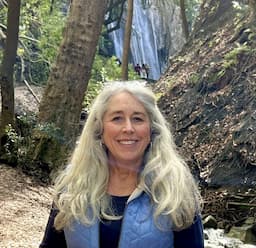What was “The Wilderness” like?
By Elizabeth Prata
As a Bible times Jewish person, talk of “the wilderness” struck fear into their heart. It was the place their ancestors wandered, thirsty and grumbling. It was where predators lurked, from the large such as hyenas and jackals and wolves, to the small, such as scorpions and snakes. It as where there was no shade from the relentless heat and sun, where thieves hid out, and where there was no food or safety.
It was where Jesus was tempted.
It was also where John the Baptist lived and preached.
It was where they went walking after a day’s journey to hear John the Baptist and perhaps to be baptized, and have their heart’s hope ignited that the Messiah was finally arriving.
“Because of its lack of water and good routes, the Judean wilderness has been (mostly) uninhabited throughout history. Consequently it was an ideal place for those seeking refuge from enemies or retreat from the world. When on the run from King Saul, David hid in various places in the Judean wilderness (the Wilderness[es] of Ziph, Maon, and En Gedi are part of the Judean Wilderness). John the Baptist preached here, and it was likely that this was the wilderness where Jesus was tempted.” Source Bibleplaces.com.
It is hard for me to imagine people today walking for a whole day over rough terrain, stones in sandals, in the blazing heat, to hear preaching. But back then they did. They came in droves to “the wilderness” to hear John the Baptist.
And all the country of Judea was going out to him, and all the people of Jerusalem; and they were being baptized by him in the Jordan River, confessing their sins. (Mark 1:5).

Then when Jesus came, he was led by the Spirit to “the wilderness” and there he stayed 40 days, being continually tempted at all points by satan. No food, no water, nothing except “beasts,” as Mark and only Mark, notes in Mark 1:13. What were these beasts?
Vincent’s Commentary says the region abounded in boars, jackals, wolves, foxes, leopards, hyenas, etc.
Yikes.
For Israel the dry, mostly uninhabited desert engendered fear and awe. It could be described like the original chaos prior to creation (Deut. 32:10; Jer. 4:23–26). Israel was able to go through the desert because God led them (Deut. 1:19). Its animal inhabitants caused even more fear—snakes and scorpions (Deut. 8:15); wild donkeys (Jer. 2:24). The desert lay waste without humans or rain (Job 38:26; Jer. 2:6). The desert was a “terrifying land” (Isa. 21:1 NASB). The only expectation for a person in the wilderness was death by starvation (Exod. 16:3). God’s judgment could turn a city into desert (Jer. 4:26), but His grace could turn the wilderness into a garden (Isa. 41:17–20). In the NT the desert was the place of John the Baptist’s ministry (Luke 1:80; 3:4) and where demon-possession drove a man (Luke 8:29). The crowds forced Jesus into the unpopulated desert to preach (Mark 1:45). Jesus took His disciples there to rest (Mark 6:31) Source- Holman Illustrated Bible Dictionary.
I kept wondering, did the beasts recognize Jesus?
And He was in the wilderness forty days being tempted by Satan; and He was with the wild beasts, and the angels were ministering to Him. (Mark 1:13 NASB1995)

Our pastor said that the inclusion of beasts in the verse but then the immediate mention of angels ministering to Jesus, likely means that a contrast is intended. Beasts opposing Jesus while Angels were helping Him.
But the beasts got me thinking of all the times God used beasts in His plan.
Beasts as used in the Bible, especially the New Testament, could be an animal that is domesticated or wild. Sacrificial or useful. Beast is sometimes used as a metaphor for a brutish nature or wicked men. Then there is THE Beast of Revelation, AKA the Antichrist. He is the man with the most brutish & wicked nature of all.
God sent the animals to the ark two by two – Genesis 7:15
God used ravens to feed Elijah – 1 Kings 17:6.
He used bears to kill the mockers – 2 Kings 2:23-24.
God closed the lion’s mouths so they would not eat Daniel in the lion’s den – Daniel 6:22.
God used Aaron to make frogs come up over the land of Egypt – Exodus 8:5-6. Same with gnats – Exodus 8:17
He used a great fish to swallow Jonah and then to spit Jonah up onto dry land – Jonah 1:17
He used a donkey to speak to Balaam – Numbers 22:28
God is sovereign over all the animals. Though the manner in which the angels were ministering to Jesus in his wilderness temptation period is not described, perhaps it was the angels who protected Jesus from the beasts while He was occupied with fasting and praying.
I was wondering if the beasts recognized Jesus in the wilderness, because Balaam’s donkey did. Numbers 22:27.
It is interesting to think of the wilderness as the place of spiritual desert. Devoid of flourishing truth, a wasteland, as the pagans who do not know Jesus are wandering in. Jesus fed the 4,000 in the desolate place east of the Sea of Galilee (Mark 8:1–9).
The wilderness was not only a setting, a location, a real place. David hid there. Jesus was tempted there. John The Baptist baptized there.

But the wilderness is also a metaphor.
In both the Old Testament and the New Testament, the wilderness has many functions. It is a place of actual barrenness and hunger, and also spiritual drought. It’s a source of nourishment from God (water and manna), but also a place where truth was preached and the seekers were nourished with that truth. It’s a location for God’s testing of His people and of Jesus too. It is the place of the backdrop for their transformation.
The People traveled through 6 actual wildernesses; Shur, Etham, Sin, Sinai, Paran, and Zin. When people today say they are having a rocky time, they may say they are metaphorically going through a “wilderness experience.”
Soon there will be no wilderness, no desert, no beasts. All will be green and healthy and flourishing. There will be no barrenness, no lack and no want. No place where dangers lurk and no place where truth isn’t present.No place of testing, for the testing will have been done and the inhabitants have passed- thanks to Jesus’ death and resurrection.
The pastures of the wilderness overflow, the hills gird themselves with joy
You visit the earth and cause it to overflow;
You greatly enrich it;
The stream of God is full of water;
You prepare their grain, for so You prepare the earth.
10You water its furrows abundantly, You settle its ridges, You soften it with showers, You bless its growth.
11You have crowned the year with Your goodness,
And Your paths drip with fatness.
12The pastures of the wilderness drip,
And the hills encircle themselves with rejoicing.
13The meadows are clothed with flocks
And the valleys are covered with grain;
They shout for joy, yes, they sing.





